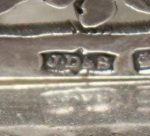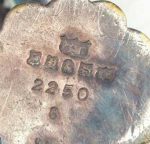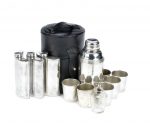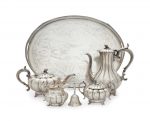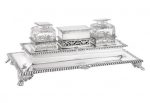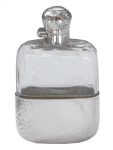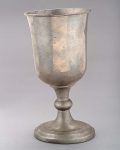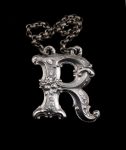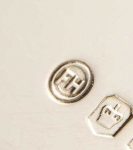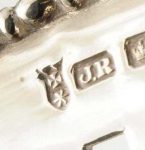James Dixon & Sons were manufacturers of silver, electroplate and Britannia metal. Originally founded as Dixon & Smith. The eldest son, William Frederick Dixon, joined c.1823 marking the start of a family enterprise. The factory was located at Cornish Place, while a London showroom opened in 1873 at 37 Ludgate Hill. The company’s trademark is distinctive by a bugle. Produced designs by Christopher Dresser (q.v.), examples of which are in the Museum’s collection. Reference: Wikipedia
The firm exhibited at the Great Exhibition in 1851, being awarded several prizes in different classes for silver and Britannia metal. Dixon’s costing book of 1879 includes designs by Christopher Dresser, registered from 1880, and these were produced until at least 1885, according to the trade catalogue issued in that year.
In the 1920s the firm began to use stainless steel to make both flatware and hollow ware and the production of silver and silver plated goods declined. In 1920 the firm was converted into a limited liability company and in 1930 the firm of William Hutton & Sons Ltd of Sheffield was absorbed into James Dixon & Sons Ltd.
In the 1980s the firm had a financial collapse and the production in Cornish Place closed in 1992. Reference: Kotler Galleries & Auctioneers.
James Dixon Silver Makers Mark circa 1905
James Dixon Trumpet Mark on Silver Plate circa 1900
A LEATHER-CASED TRAVELLER’S COCKTAIL SET FOR SIX PERSONS BY JAMES DIXON & SONS, CIRCA 1909, black pigskin cylindrical case, opening to interior fitted with central electro-plated cocktail shaker containing a set of six stacked tumblers and a bitters bottle, surrounded by three curved hip-flasks marked ‘Gin’, ‘French’ and ‘Italian’, all with maker’s stamps to underside, the case 19cm high overall.
Sold for £ 687 inc. premium at Bonhams in 2018
AN ENGLISH SILVER-PLATE FOUR-PIECE TEA AND COFFEE SERVICE, A SILVER-PLATE TRAY AND A TABLE BELL THE SERVICE MARK OF JAMES DIXON & SONS, LATE 19TH/20TH CENTURY The service comprising a teapot with hinged cover, a coffee pot with hinged cover, a two-handle sugar bowl and cover, and a cream jug, each marked on base; the oval silver-plate tray marked on base; the silver-plate bell marked on rim 22 3/8 in. (56.8 cm.) wide, the tray; 10 in. (25.4 cm.)
Sold for USD 5,250 at Christies in 2016
Victorian Silver Standish James Dixon & Sons Ltd., Sheffield, circa 1875-76 Of stepped rectangular form, with two glass ink pots, on paw feet. Height 4 1/2 inches (11.4 cm), width 13 1/4 inches (33.6 cm), depth 7 1/2 inches (18.6 cm), approximately 42 ounces, weighable.
Sold for $1,500 (includes buyer’s premium) at Doyle New York in 2013
A James Dixon & Sons Hammered Silver and Glass Flask england, circa 1911 2.5″ W x 1″ D x 4.5″ H
Sold for $200 at Leslie Hindman Auctioneers in 2018
Goblet English (Sheffield) about 1825 James Dixon and Sons (English, working in Sheffield, 1806–1976)
Goblet. molded and splayed base with bulb in stem. Curved sides and molded rim. From Universalist Church, Brewster, Mass.
Reference: Museum of Fine Arts Boston
A Victorian silver two-handled galleried tray, James Dixon & Sons, Sheffield, 1878 rectangular with cut-corners and galleried rim, the center engraved with scrolling acanthus, floral swags, and flowerheads on partly-matted ground marked on surface and rim length over handle 29 1/4 in. 74.3 cm 198 oz 6158 g
Sold for 7,500 USD at Sothebys in 2018
Bottle ticket in the form of a letter R. Silver, ornate Roman capital, repoussé with flowers and scrolls; chain attached. 1863-1864 James Dixon and Sons (maker)
Reference: © Victoria and Albert Museum
